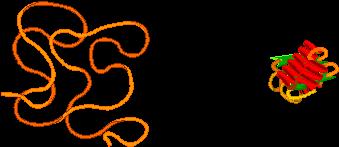- B.S. Peking University (1983)
- M.S. Peking University (1986)
- Ph.D. Iowa State University (1994)
- Lecturer, Tsinghua University (1986-89)
- Postdoctoral Research Associate, Harvard University (1994-97)
- Director’s Postdoctoral Fellow, Los Alamos National Laboratory (1997-99)
The focus of our research is to study how proteins fold from random or quasi-random coils to their biologically functional conformations. We are particularly interested in the kinetic aspects of the folding mechanisms. Novel laser spectroscopic methods are being used and developed to study the early folding events and folding intermediates.
Fast events in protein folding
Understanding how folding proceeds at early time is apparently essential to the elucidation of the entire folding mechanism. To access and characterize the early folding events requires a fast initiation method and a probe that has structural specificity. Our general approach is to use novel laser-induced temperature-jump and fast-mixing techniques to initiate refolding/unfolding on nanosecond or microsecond timescales, and use time-resolved infrared and fluorescence spectroscopies to probe the subsequent folding dynamics and structural ordering along the folding/unfolding pathways. This approach provides not only fast time resolution, but also the necessary structural sensitivity, since both infrared and fluorescence are well-established conformation probes. Recent works involve the study of the helix-coil transition, helix-helix interaction, and ß-sheet formation.

Single-molecule study of protein conformation dynamics
Recently, a new view of the kinetics of protein folding has emerged based on the new conceptual framework of statistical mechanical models, replacing the pathway concept with the broader notion of rugged energy landscapes. The heterogeneity in folding kinetics therefore can be realized as a result of the motions of an ensemble of protein conformations on the rugged energy hypersurface that is biased towards the native state, analogous to parallel diffusion-like processes. Studying folding dynamics statistically using single-molecule techniques will provide unique information regarding a protein's folding energy landscape, which may not be obtained by conventional ensemble studies since the conventional measurements of molecular dynamics in the condensed phase represent only averages over large numbers of molecules and events. Currently, confocal fluorescence spectroscopy and microscopy are being used to study protein spontaneous fluctuation and folding dynamics at single-molecule level.
S. Mukherjee, P. Chowdhury and F. Gai, “Infrared study of the effect of hydration on the amide I band and aggregation properties of helical peptides,” J. Phys. Chem. B 2007, 111, 4596.
Y. Xu, P. Purkayastha, and F. Gai, “Nanosecond folding dynamics of a three-stranded beta-sheet,” J. Am. Chem. Soc. 2006, 128, 15836.
M. R. Bunagan, L. Cristian, W. F. DeGrado, and F. Gai, “Truncation of a cross-linked GCN4-p1 coiled-coil leads to ultrafast folding,” Biochemistry 2006, 45, 10981.
D. Du, and F. Gai, “Understanding the folding mechanism of alpha-helical hairpin. Biochemistry 2006, 45, 13131.
M. J. Tucker, J. Tang, and F. Gai, “Probing the kinetics of membrane-mediated helix folding,” J. Phys. Chem. B 2006, 110, 8105.
M. J. Tucker, R. Oyola, and F. Gai, “Conformational distribution of a 14-residue peptide in solution: a FRET study,” J. Phys. Chem. B 2005, 109, 4788.
D. G. Du, Y. J. Zhu, C-Y. Huang, and F. Gai, “Understanding the key factors that control the rate of -hairpin folding,” Proc. Natl. Acad. Sci. USA 2004, 101, 15915.
Y. J. Zhu, D. O. V. Alonso, K. Maki, C-Y Huang, S. J. Lahr, V. Daggett, H. Roder, W. F. DeGrado, and F. Gai, “Ultrafast folding of alpha3D, a de novo designed three-helix bundle protein,” Proc. Natl. Acad. Sci. USA 2003, 100, 15486.
Z. Getahun, C-Y. Huang, T. Wang, B. D. León, W. F. DeGrado, and F. Gai, “Using nitrile-derivatized amino acids as infrared probes of local environment,” J. Am. Chem. Soc. 2003, 125, 405.
C.-Y. Huang, Z. Getahun, Y. J. Zhu, J. W. Klemke, W. F. DeGrado, and F. Gai, “Helix formation via conformation diffusion search,” Proc. Natl. Acad. Sci. USA 2002, 99, 2788.

